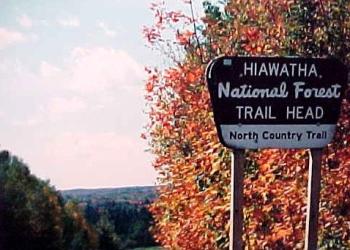Federal wildfire policy sparks debate: timber or trees?

The Hiawatha National Forest covers about 879,000 acres in the Upper Peninsula. Courtesy Photo from the National Park Service
LANSING – New federal policy is aimed at addressing the nation’s wildfire crisis by boosting timber production, but some experts say it’s not expected to have a major impact in Michigan.
There are more than 2.5 million acres of national forest in the Northern Lower Peninsula and Upper Peninsula, but most forestland in Michigan is owned by the state, local governments and private entities and individuals.
The policy change is reflected in federal actions such as President Donald Trump’s “Empowering Commonsense Wildfire Prevention and Response” executive order and provisions about the sale of timber and long-term contracts by the U.S. Forest Service and the Bureau of Land Management in the One Big Beautiful Bill Act.
For example, Trump’s “Immediate Expansion of American Timber Production” executive order was promoted as a way to prevent wildfires by reducing fuel loads in high-risk areas.
In part, it requires federal agencies to update guidance to speed up timber delivery and delay or suspend regulations to expedite permitting and reduce environmental reviews.
In addition, U.S. Secretary of Agriculture Brooke Rollins issued a memorandum stating that her department’s future efforts will promote the production of timber, remove hazardous fuels and remove trees damaged by natural disasters.
Supporters of the policy change say it also will provide a major boost for the U.S. timber industry, as well as preventing wildfires.
However, some experts, including Shivan Gc, an assistant professor in the Michigan State University Department of Forestry, criticize the new policy as more focused on the economy than on the environment. She researches forest economics and environmental policy.
Gc said the policy change may increase timber production in the short term but that she doesn’t expect a big impact on the economy, especially in Michigan, since it primarily applies to federal land.
That includes areas managed by the U.S. Forest Service (under the Department of Agriculture) and the Bureau of Land Management (under the Department of the Interior), and does not apply to state or private forests.
David Prince, the forest planning and operations manager at the Department of Natural Resources, also said the law will apply only to federal forests and will not affect state and privately owned forests.
Prince said there are three federal forests in Michigan: the Huron-Manistee National Forest in the Northern Lower Peninsula, the Hiawatha National Forest in the eastern and central UP and the Ottawa National Forest in the western UP.
Michigan has almost 4 million acres of state forest.
According to Gc, federal forests make up about 31% of the nation’s total forestland. The non-federal forests are owned mostly by private individuals and companies, with roughly 11% managed by state and local governments.
“These (federal forests) are not distributed evenly across the country,” said Gc. “So, if you think about the Rocky Mountain region or Pacific coast, a large percentage of those forests are federally owned, versus Michigan, where 62% of the forests are privately owned.”
Thus, the new policy’s on-the-ground impact in a state like Michigan may be limited, experts say.
The question of the policy’s economic scope will lead directly to specific government actions on federal forestlands.
Gc said, “So these kinds of treatments probably may be like active forest management kind of strategies, which are going ahead and identifying areas that need to be thinned and then removing excess dead trees or downed woody material from the forest floor.
“Those create hazardous fuel buildup, so removing those should have some positive effects on forest health.
“But that also depends upon how much will be removed. And if you hit that sustainability balance, then it could have negative effects on wildlife or sensitive species,” said Gc.
While the new federal policy prioritizes timber production and fire suppression, a more scientific and balanced strategy, according to Gc, would focus on a different set of priorities.
“If you focus more on the environmental aspect of it, then you’d probably frame it a little bit differently,” she said, “Not just opening up forests for timber production or increasing timber harvest, but maybe focusing more on science, like fire management science or ecological aspects of it.”
It also would take into consideration and incorporate the public’s view and not reduce public comment, she said.




